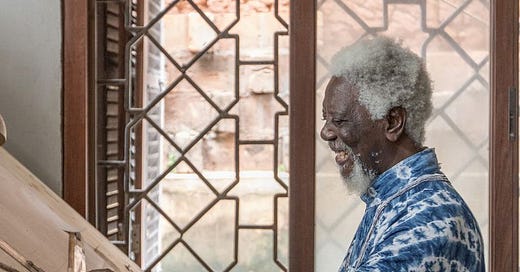020. The Architectural Marvel in Demas Nwoko's Works (series)
Highlighting the Dominican Monastery and the New Culture Studios

Demas Nwoko is a man of multivariate art and visionary will. This is evident in the masterpieces he built in Ibadan. Born in 1935 into a royal family that originates from the Oba of Benin, Nwoko started out as an admirer of architecture at the age of three in Idumeje-Ugboko—his hometown where he indulged in recreating versions of the wall around him during playtime. He apprenticed as a draughtsman before pursuing a major in sculpture at the College of Arts, Science and Technology in Zaria, and later in Paris where he studied scenic theatre.
A nationalist by heart, Nwoko’s artistic expression is keenly borderless yet rooted in Africanness; he is known for Fine Art (Painting, Sculpting), Architecture (Design and Build), Stage Design, Theatre Directing, wood working, and writing. His works, if allowable by him, can be enlisted into the studies of cultural heritage, religious art, social art, philosophy, history, and natural sciences. Suffice to say that the architectural representation of his ideas is as complex and dynamic as his views on religion. For example, on architecture, he combines indigenous materials sourcing, nature conservative techniques, with absolute intentionality and functionality.
Whereas on religion, knowing the colonial principle that governed the introduction of Christianity into Nigeria, Nwoko accepts his Christian upbringing, not blindly, but with the gusto to indigenize it. This he also did with his art and architecture.
Nwoko’s architectural design is markedly indigenous and it is such that megaphones African architectural independence from the clutches of European embellishments. His design is of a versatile kind, one that reinforces awe in its beholder. His two architectural masterworks in Ibadan, simply 4.3 kilometres away from each other, are legacy of his startling resourcefulness.

Situated in Samonda with the University of Ibadan to the East, and The Polytechnic Ibadan to the Northwest, Dominican Monastery—housed in Dominican University— is not only a garnishing icon, its inner and outer structure is a mesmerizing architectural performance deserving of flying ovations. Sitting amidst greeneries, surrounded by a pool that collects rain water, the Monastery building—made mostly of latcrete— is a marriage between nature and indigeneity. While the sculpted art that adorns the outer part of the Monastery in a semi-circular symmetry evokes images of Nsibidi hieroglyphics and correlations with ancient Egyptian hieroglyphics, the wooden pillars and the design chiselled upon them (in the inner part of the monastery) induce a similarity to Osun-Osogbo Grove. A clueless religious believer may ascribe such architectural correlations to idolatory, but the design is merely an adaptation necessary to make acquaintance with African art and arouse a great sense of belonging in Nigerian converts.
The New Culture Studios invokes similar African ambiences. It glazes Oremeji Hill at Mokola and is peculiarly an African-European syncretic proof of African architectural dynamics. Even more, a walk up the hill to the Studios alludes to taking a short pilgrimage to the Temple of Delphi—suggesting a spiritual annotation behind its location. The New Culture Studios is neither Greek nor a temple; it is an African ‘colosseum’ for creativity— a spatial-communion of art, artists, and audience. Dominican Monastery, on the other hand, is a shrine consecrated to God in the image of the African. With these two masterworks, the unity of mind and matter is accomplished and conceivably inducted as the pinnacle of African architectural triumvirate plus one: God, nature, spaces and people.
You can have a round-view of these architectural wonders here (Dominican Chapel) and here (New Culture Studios). See you in the next post!





